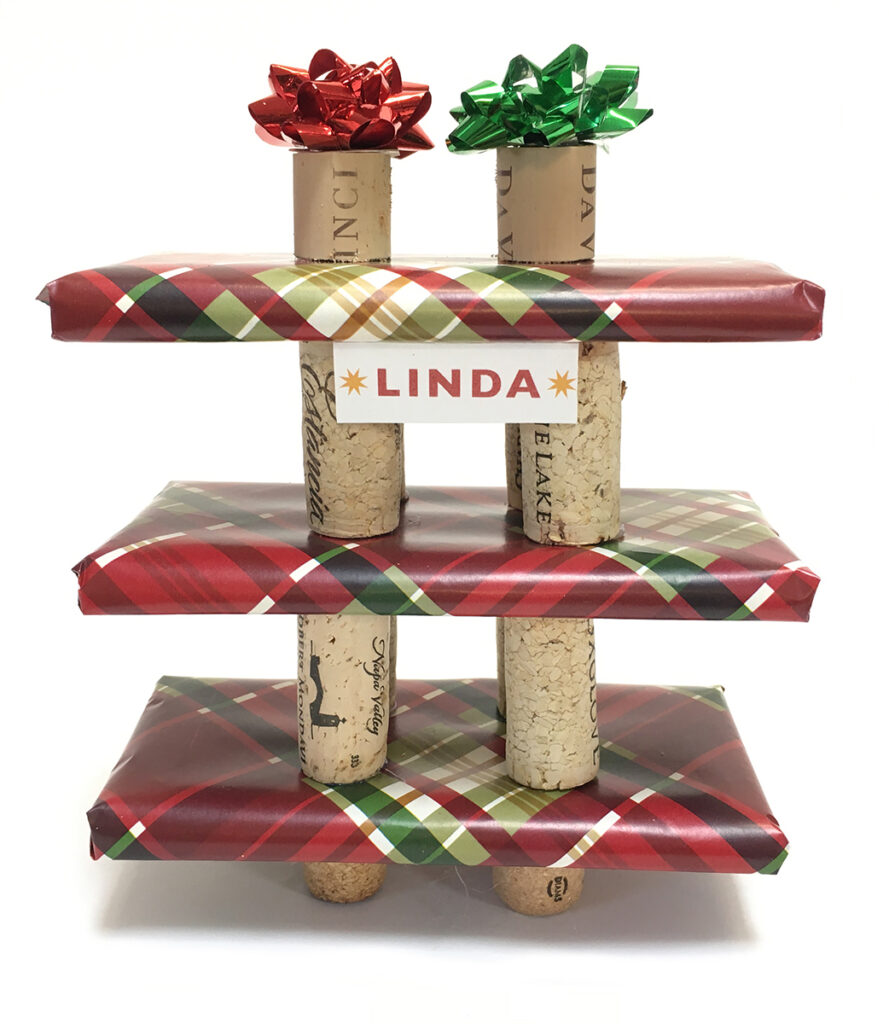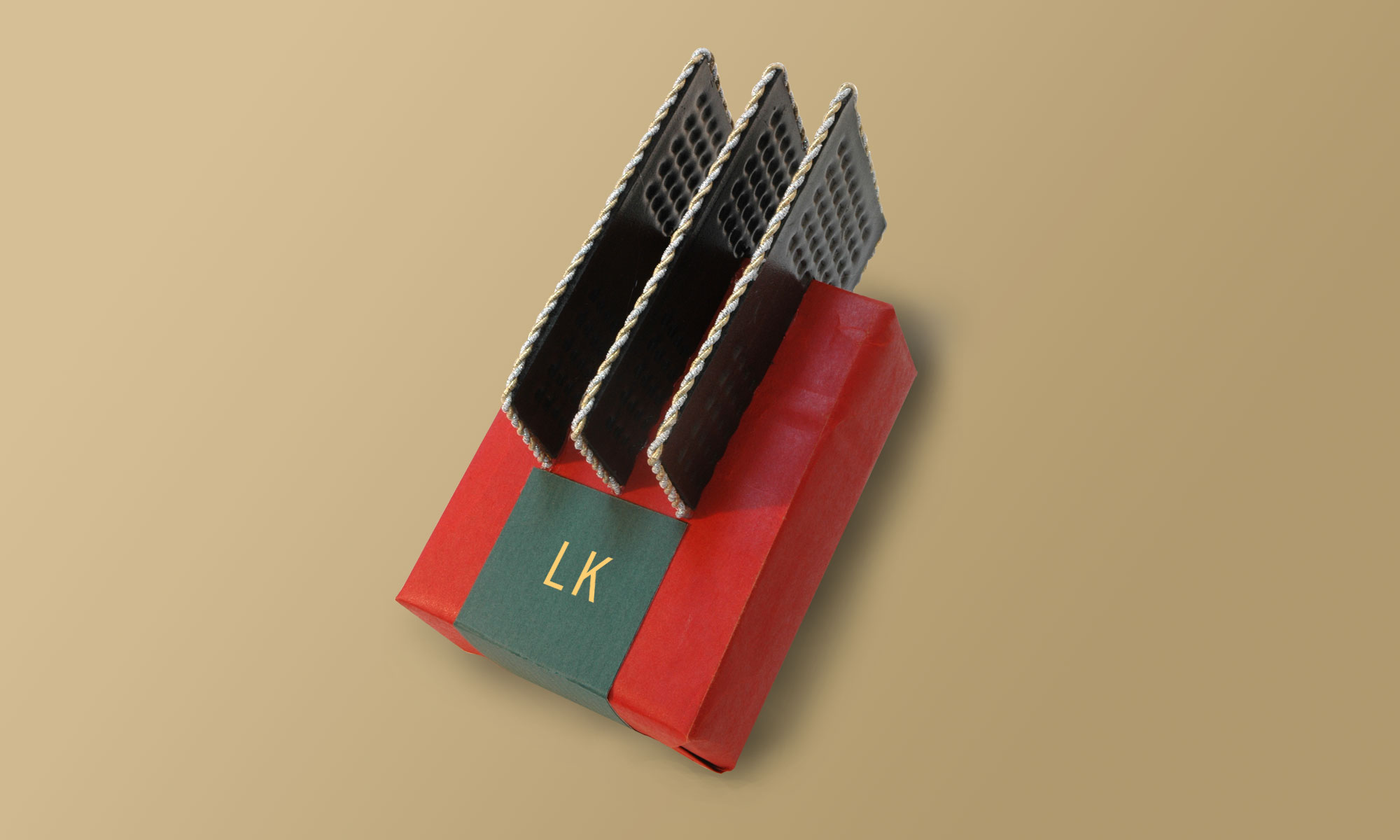Three identical pieces make up the gift. I wrapped them all the same. Then I placed four corks to space them apart while make it one. There are four half corks under the ground floor. I put two corks on the top with two tiny bows.


wrap with anything ❖ john boak
Three identical pieces make up the gift. I wrapped them all the same. Then I placed four corks to space them apart while make it one. There are four half corks under the ground floor. I put two corks on the top with two tiny bows.

I collected a handful of twigs that had fallen off their trees during a recent icy snowstorm. My intention was to replace two damaged twigs on an old pine-log reindeer christmas sculpture. But two other twigs from our backyard proved better. When it came time for the first wrap of the season, I thought these twigs might make a fine “bow” when bundled together with ribbon and place cross-wise on the long white box of the gift.
But that idea proved wrong in execution. The bundle of twigs never looked elegant. The twigs were awkward with each other. When I paused to ponder new design vectors the twigs piped up with “legs,” a wonderful but often overlooked wrap tactic.
I then made a wrapper for the box, using the white bag in which the gift’s source store had made the delivery to me. The wrapper covered only nlne of the gift’s eleven inches length and used no glue or tape on the gift’s box. That meant that the box could be slid out of the wrapper quickly and effortlessly, with no ripping or tearing.
I divided the sides of the box-and-wrapper into sixths, marking the five spots that separated those sixths. I began hot gluing the legs onto the box. Once they had cooled, I trimmed them to a common length from the bottom of the box. I could then stand up the whole rig, stand back and judge the result.
I felt it could use some color. So I cut up ribbon fragments —purple, teal, red, and gold— to become abstract leaves. I glued them on, examining both sides as I went.
For the label, I made a strip of typography, printed it out, and cut it into a ribbon. I folded the ends and tucked them into the ends of the white wrapper.
I thought of the form for this one before anything else. I had saved some Apple cable boxes. They are white and have relatively little type on them. I conceived of them as legs. I covered their largest surfaces with interesting paper. What you see here is dark green, finely-corrugated, specialty stock. The back sides are a medium gray cover stock with lots of visible fiber. I put squares of bright red paper in the center of all four large sides. I then wrapped the gift’s box with white paper and began to play with various arrangements, some fully symmetrical, other cantilevered. I chose the stability of symmetry. I added two pieces of red, textured ribbon, applying them on the gift box to be parallel and aligned to the supporting boxes. I then glued them on, adding an invisible cross-beam of the green corrugated paper between the two boxes to provide stability. I felt the whole thing needed the addition of an non-rhomboid form. I found the pale green ball, and glued it on. Last of all I added the recipient’s name on a small red square.
I went for speed on this one. Chopped down an oatmeal box. Placed the gift in tissue. Glued on a new bottom. Roll-wrapped it in pink tissue using both tape and glue to fix the ends. I left a lot of extra paper on the tail end and twisted it off-center to make a pigtail. I had to work bit of hot glue into the folds of the twisted tissue to make the tail stable and curved. Next I wrapped a deodorant cap with tissue paper and glued it onto the body for the snout, adding the paper fascia with marker nostrils. The eyes are black paper. The mouth is a piece of thin black ribbon, glued to the pink body, and up to the underside of the snout, about an inch away from the body. That means that the smiling mouth is not actually on the pig, but it worked visually. Next I made the legs, using two twigs, each cut at a 45 degree angle to make four legs. I cut little tiny square holes in the pink tissue wrap, which allowed me to glue the legs right to the cardboard of the oatmeal box, assuring a good grip. Lastly, I cut out ears from cover stock, folding the bottom to make an attachment tab; I cut a slit into that tab, which allowed me to bend the ears vertically to get a good simulation of a pigs ear. The pig has been well received.
A very small package can have lots of impact. I wrapped the gift with foil paper. I cut four legs from my twig stash and glued them directly to the wrap. Next I reached into my odd materials bin and pulled out a scrap of fur that had been waiting for its moment. With a few dabs of glue I had the latest addition to my critter wraps collection.
I needed to wrap some awkward high-country gear, snowshoes. I knew I would have to neutralize their various edges and somewhat-sharp parts. So I wrapped them first in bubble wrap. Then I began apply layers of wrapping-paper scraps. Each piece of paper, long or square was given folded edges, as in creating band wraps. The folding ads dimension and and hint of finish to the scrap. Hot glue was my binding medium. I applied the large, and longer pieces first, adding rectangles and skinny bands later. When enough pieces are applied the wrap has stability you do not expect when you apply the first, ungainly pieces.
The skeleton is made of cast paper pieces that are used to protect the corners or edges of furniture being shipped. I discovered them in the alley a fews days before I made this wrap. As soon as I saw them I imagined what they could do: easy to cut, easy to glue. Long, light, rigid and versatile.
I rested the somewhat squishy scrap wrap on my work bench. I studied it with a measuring tape, choosing a length for the long parts. I cut the verticals and lay them upon the wrap. I measured and cut short horizontals, one longer, one shorter, to make the vertical angle inward as the tower rises. Hot glue rapidly joined the four pieces. Once I had a similar second side, I cut four more horizontals and assembled the whole tower around the wrapped gift.
Ribbons on the verticals brought the gift-wrap feeling to the cast-board verticals. But the top seemed incomplete. So I glued pine cones to pine twigs, to make four finials to complete the tower’s architecture. Since the gift had to be carried over the river and through the woods, I attached the pine-cone assemblies using using velcro patches.
I was impressed by the sturdiness of the final piece. And the contrast between the exoskeleton’s linear form and the brecciated patches of the scrap wrap was satisfying.
It all began with a box and the black paper. The gold pyramids had arrived a few months earlier. The contain pyramidal tea bags. The gold foil was on the inside of these beautiful little boxes. They had no glue, just folds and inserts, so I could unfold and refold them, revealing the foil. I know that ribbon would bring this wrap nearly to completion. I picked a fat one with gold edges. Next I added a thick plastic cap from some cosmetic product, an item that I had saved for a long time.
The wrap looked better standing rather than lying down. But it would not stand up on its own. So added feet. Its label was a stick-on file label.
Wrap art contributor Carmen Zimmer submitted this imaginative wrap. With an odd shaped gift, the flexibility of tissue was the choice for a base wrap. She used the contrast of color for graphic punch.
But the material of the moment was chenille (pipe cleaner) stems that form the animal’s fur. To place them she wisely avoided my usual hot-glue technique and instead included a layer of styrofoam underneath the magenta tissue. Then it was a simple snip and poke to place each one.
Corks made legs. And she happened to have eyes left over from some toy to complete this curious creature.
While cleaning the kitchen one day, I consolidated an excess of plastic knives, spoons and forks. The beauty of multiples forced me to save them in plastic bags. The knife bag went into my wrap warehouse.
On Christmas day my son was attending to his last-minute wraps, and I volunteered to wrap one of his smallest presents.
I gave it a white-paper wrap and then began gluing plastic knives onto the box. I looked upon them as lines or strokes, and began creating a constructivist composition of angles. I had planned, and still do plan, to glue on a lot more of them. But we ran out of time and so this was my wrap. The dense-pack knife wrap awaits some future opportunity. In the meantime, the relatively sparse application of knives works quite well, and perhaps better honors its derivation in Russian artists.
The wrap began as I rummaged through my wrap paper drawer and discovered an old type catalog, “X-Height.” It’s tall large page size, each page with a grid of square type samples, offered a paper suitable for small boxes, and one that was rich in non-repeating graphic forms.
I wrapped the present. However, the end folds did not quite cover each other, so I reached into the ribbon box, and retrieved a wide orange ribbon. I like to use ribbon on the small sides of a wrap; it provides more color and a texture change, but it leaves the stage empty for sculptural play.
Next I glued on four wine-cork legs. Raising a wrap on legs has an amusing and quietly transforming effect on any gift. The resonance with tables and benches lifts the wrap away from the metaphor of storage or inventory and places it into the non-wrap realm of furnishings.
At this point I did not have to place anything on this table. The paper’s symbol-filled square were amply entertaining. But I was having fun, and began to play with the variety of wood and rock materials cluttering my studio. A pedestal of sample engineered bamboo felt good sitting on the type-sample wrap. I then tried numerous rocks and twigs until I finally settled on the flat gray “label” rock and its companion, a shiny black rock. I added the name of the recipient in white colored pencil, and glued all three pieces onto the table wrap.